Thermal Imaging Shows Submarine Groundwater Discharge Plumes Associated with Ancient Settlements on Rapa Nui (Easter Island, Chile)
Abstract
:1. Introduction
1.1. Rapa Nui Hydrogeology
1.2. Ancient Rapa Nui Water Management
2. Materials and Methods
3. Results
4. Discussion
5. Conclusions
Supplementary Materials
Author Contributions
Funding
Institutional Review Board Statement
Informed Consent Statement
Data Availability Statement
Acknowledgments
Conflicts of Interest
Appendix A
| Location | Salinity (ppt) | Easting | Northing |
|---|---|---|---|
| Hanga Te‘e * | 3.7 | 662,164 | 6,994,219 |
| Hanga Te‘e * | 5.3 | 662,248 | 6,994,204 |
| Hanga Te‘e * | 6.2 | 662,217 | 6,994,224 |
| Hanga Te‘e * | 9.3 | 662,238 | 6,994,166 |
| Hanga Te‘e | 11.6 | 662,192.5 | 6,994,234 |
| Hanga Te‘e | 16.2 | 662,035 | 6,994,140 |
| Hanga Te‘e | 21.3 | 662,011.9 | 6,994,112 |
| Te Ipu Pu | 2.8 | 665,982.7 | 7,004,547 |
| Te Ipu Pu | 6.4 | 665,982.6 | 7,004,550 |
| Te Ipu Pu | 8.1 | 666,003.5 | 7,004,557 |
| Te Ipu Pu | 9.7 | 665,995.8 | 7,004,530 |
| Te Ipu Pu | 10.2 | 666,020.6 | 7,004,545 |
| Hanga Ho‘onu | 3.4 | 668,728.9 | 7,002,617 |
| Hanga Ho‘onu | 9 | 668,732.9 | 7,002,616 |
| Hanga Ho‘onu | 10.1 | 668,712.9 | 7,002,644 |
| Hanga Ho‘onu | 13.5 | 668,740.9 | 7,002,614 |
| Hanga Ho‘onu | 21.8 | 668,710.9 | 7,002,638 |
| Hanga Ho‘onu | 25.5 | 668,660 | 7,002,753 |
References
- Taniguchi, M.; Dulai, H.; Burnett, K.M.; Santos, I.R.; Sugimoto, R.; Stieglitz, T.; Kim, G.; Moosdorf, N.; Burnett, W.C. Submarine Groundwater Discharge: Updates on Its Measurement Techniques, Geophysical Drivers, Magnitudes, and Effects. Front. Environ. Sci. 2019, 7, 141. [Google Scholar] [CrossRef]
- Rodellas, V.; Garcia-Orellana, J.; Masqué, P.; Feldman, M.; Weinstein, Y. Submarine Groundwater Discharge as a Major Source of Nutrients to the Mediterranean Sea. Proc. Natl. Acad. Sci. USA 2015, 112, 3926–3930. [Google Scholar] [CrossRef] [PubMed] [Green Version]
- Moore, W.S. The Effect of Submarine Groundwater Discharge on the Ocean. Annu. Rev. Mar. Sci. 2010, 2, 59–88. [Google Scholar] [CrossRef] [PubMed] [Green Version]
- Attias, E.; Thomas, D.; Sherman, D.; Ismail, K.; Constable, S. Marine Electrical Imaging Reveals Novel Freshwater Transport Mechanism in Hawai‘i. Sci. Adv. 2020, 6, eabd4866. [Google Scholar] [CrossRef] [PubMed]
- Burnett, W.C.; Aggarwal, P.K.; Aureli, A.; Bokuniewicz, H.; Cable, J.E.; Charette, M.A.; Kontar, E.; Krupa, S.; Kulkarni, K.M.; Loveless, A.; et al. Quantifying Submarine Groundwater Discharge in the Coastal Zone via Multiple Methods. Sci. Total Environ. 2006, 367, 498–543. [Google Scholar] [CrossRef]
- Mallast, U.; Schubert, M.; Schmidt, A.; Knoeller, K.; Stollberg, R.; Siebert, C.; Merz, R. Combination of Satellite Based Thermal Remote Sensing and in Situ Radon Measurements and Field Observations to Detect (Submarine) Groundwater Discharge. AGU Fall Meet. Abstr. 2012, 2012, H24C-06. [Google Scholar]
- Wilson, J.; Rocha, C. Regional Scale Assessment of Submarine Groundwater Discharge in Ireland Combining Medium Resolution Satellite Imagery and Geochemical Tracing Techniques. Remote Sens. Environ. 2012, 119, 21–34. [Google Scholar] [CrossRef]
- Casas-Mulet, R.; Pander, J.; Ryu, D.; Stewardson, M.J.; Geist, J. Unmanned Aerial Vehicle (UAV)-Based Thermal Infra-Red (TIR) and Optical Imagery Reveals Multi-Spatial Scale Controls of Cold-Water Areas Over a Groundwater-Dominated Riverscape. Front. Environ. Sci. 2020, 8, 64. [Google Scholar] [CrossRef]
- Lee, E.; Yoon, H.; Hyun, S.P.; Burnett, W.C.; Koh, D.-C.; Ha, K.; Kim, D.; Kim, Y.; Kang, K. Unmanned Aerial Vehicles (UAVs)-Based Thermal Infrared (TIR) Mapping, a Novel Approach to Assess Groundwater Discharge into the Coastal Zone. Limnol. Oceanogr. Methods 2016, 14, 725–735. [Google Scholar] [CrossRef]
- Dugdale, S.J.; Kelleher, C.A.; Malcolm, I.A.; Caldwell, S.; Hannah, D.M. Assessing the Potential of Drone-Based Thermal Infrared Imagery for Quantifying River Temperature Heterogeneity. Hydrol. Process. 2019, 33, 1152–1163. [Google Scholar] [CrossRef]
- Briggs, M.A.; Dawson, C.B.; Holmquist-Johnson, C.L.; Williams, K.H.; Lane, J.W. Efficient Hydrogeological Characterization of Remote Stream Corridors Using Drones. Hydrol. Process. 2019, 33, 316–319. [Google Scholar] [CrossRef] [Green Version]
- Young, K.S.R.; Pradhanang, S.M. Small Unmanned Aircraft (SUAS)-Deployed Thermal Infrared (TIR) Imaging for Environmental Surveys with Implications in Submarine Groundwater Discharge (SGD): Methods, Challenges, and Novel Opportunities. Remote Sens. 2021, 13, 1331. [Google Scholar] [CrossRef]
- Abolt, C.; Caldwell, T.; Wolaver, B.; Pai, H. Unmanned Aerial Vehicle-Based Monitoring of Groundwater Inputs to Surface Waters Using an Economical Thermal Infrared Camera. Opt. Eng. 2018, 57, 053113. [Google Scholar] [CrossRef]
- Ferrara, C.; Lega, M.; Fusco, G.; Bishop, P.; Endreny, T. Characterization of Terrestrial Discharges into Coastal Waters with Thermal Imagery from a Hierarchical Monitoring Program. Water 2017, 9, 500. [Google Scholar] [CrossRef]
- DiNapoli, R.J.; Lipo, C.P.; Brosnan, T.; Hunt, T.L.; Hixon, S.; Morrison, A.E.; Becker, M. Rapa Nui (Easter Island) Monument (Ahu) Locations Explained by Freshwater Sources. PLoS ONE 2019, 14, e0210409. [Google Scholar] [CrossRef]
- Hixon, S.; DiNapoli, R.J.; Lipo, C.P.; Hunt, T.L. The Ethnohistory of Freshwater Use on Rapa Nui (Easter Island, Chile). J. Polyn. Soc. 2019, 128, 163–189. [Google Scholar] [CrossRef]
- Brosnan, T.; Becker, M.W.; Lipo, C.P. Coastal Groundwater Discharge and the Ancient Inhabitants of Rapa Nui (Easter Island), Chile. Hydrogeol. J. 2019, 27, 519–534. [Google Scholar] [CrossRef]
- Vogt, B.; Moser, J. Ancient Rapanui Water Management—German Archaeological Investigations in Ava Ranga Uka A Toroke Hau. Rapa Nui J. 2010, 24, 18–26. [Google Scholar]
- Vogt, B.; Kühlem, A. By the Quebrada of Ava Ranga Uka A Toroke Hau—about landscape transformation and the significance of water and trees. In Cultural and Environmental Change on Rapa Nui; Haoa-Cardinali, S., Ingersoll, K.B., Ingersoll, D.W., Jr., Stevenson, C.M., Eds.; Routledge: New York, NY, USA, 2018; pp. 113–132. [Google Scholar]
- Bandy, M.C. Geology and Petrology of Easter Island. Bull. Geol. Soc. Am. 1937, 48, 1589–1610. [Google Scholar] [CrossRef]
- Baker, P.E.; Buckley, F.; Holland, J.G. Petrology and Geochemistry of Easter Island. Contrib. Mineral. Petrol. 1974, 44, 85–100. [Google Scholar] [CrossRef]
- Clark, J.G.; Dymond, J. Geochronology and Petrochemistry of Easter and Sala y Gomez Islands: Implications for the Origin of the Sala y Gomez Ridge. J. Volcanol. Geotherm. Res. 1977, 2, 29–48. [Google Scholar] [CrossRef]
- Miki, M.; Inokuchi, H.; Yamaguchi, S.; Matsuda, J.; Nagao, K.; Isezaki, N.; Yaskawa, K. Geomagnetic Paleosecular Variation in Easter Island, the Southeast Pacific. Phys. Earth Planet. Inter. 1998, 106, 93–101. [Google Scholar] [CrossRef]
- O’Connor, J.M.; Stoffers, P.; McWilliams, M.O. Time-Space Mapping of Easter Chain Volcanism. Earth Planet. Sci. Lett. 1995, 136, 197–212. [Google Scholar] [CrossRef]
- Vezzoli, L.; Acocella, V. Easter Island, SE Pacific: An End-Member Type of Hotspot Volcanism. Geol. Soc. Am. Bull. 2009, 121, 869–886. [Google Scholar] [CrossRef] [Green Version]
- Haase, K.M.; Stoffers, P.; Garbe-Schönberg, C.D. The Petrogenetic Evolution of Lavas from Easter Island and Neighbouring Seamounts, Near-Ridge Hotspot Volcanoes in the SE Pacific. J. Petrol. 1997, 38, 785–813. [Google Scholar] [CrossRef]
- Herrera, C.; Custodio, E. Conceptual Hydrogeological Model of Volcanic Easter Island (Chile) after Chemical and Isotopic Surveys. Hydrogeol. J. 2008, 16, 1329–1348. [Google Scholar] [CrossRef]
- Margalef, O.; Martínez Cortizas, A.; Kylander, M.; Pla-Rabes, S.; Cañellas-Boltà, N.; Pueyo, J.J.; Sáez, A.; Valero-Garcés, B.L.; Giralt, S. Environmental Processes in Rano Aroi (Easter Island) Peat Geochemistry Forced by Climate Variability during the Last 70 Kyr. Palaeogeogr. Palaeoclimatol. Palaeoecol. 2014, 414, 438–450. [Google Scholar] [CrossRef] [Green Version]
- Horrocks, M.; Baisden, W.T.; Harper, M.A.; Marra, M.; Flenley, J.; Feek, D.; Haoa-Cardinali, S.; Keller, E.D.; Nualart, L.G.; Gorman, T.E. A Plant Microfossil Record of Late Quaternary Environments and Human Activity from Rano Aroi and Surroundings, Easter Island. J. Paleolimnol. 2015, 54, 279–303. [Google Scholar] [CrossRef]
- Genz, J.; Hunt, T.L. El Nino/Southern Oscillation and Rapa Nui Prehistory. Rapa Nui J. 2003, 17, 7–14. [Google Scholar]
- Morrison, A. An Archaeological Analysis of Rapa Nui Settlement Structure: A Multi-Scalar Approach. Ph.D. Thesis, University of Hawaii, Manoa, Honolulu, HI, USA, 2012. [Google Scholar]
- Stevenson, C.M.; Puleston, C.O.; Vitousek, P.M.; Chadwick, O.A.; Haoa, S.; Ladefoged, T.N. Variation in Rapa Nui (Easter Island) Land Use Indicates Production and Population Peaks Prior to European Contact. Proc. Natl. Acad. Sci. USA 2015, 112, 1025–1030. [Google Scholar] [CrossRef] [Green Version]
- Puleston, C.O.; Ladefoged, T.N.; Haoa, S.; Chadwick, O.A.; Vitousek, P.M.; Stevenson, C.M. Rain, Sun, Soil, and Sweat: A Consideration of Population Limits on Rapa Nui (Easter Island) before European Contact. Front. Ecol. Evol. 2017, 5, 69. [Google Scholar] [CrossRef] [Green Version]
- Cañellas-Boltà, N.; Rull, V.; Sáez, A.; Margalef, O.; Bao, R.; Pla-Rabes, S.; Blaauw, M.; Valero-Garcés, B.; Giralt, S. Vegetation Changes and Human Settlement of Easter Island during the Last Millennia: A Multiproxy Study of the Lake Raraku Sediments. Quat. Sci. Rev. 2013, 72, 36–48. [Google Scholar] [CrossRef] [Green Version]
- Caviedes, C.N.; Waylen, P.R. Rapa Nui: A Climatically Constrained Island? Rapa Nui J. 2011, 25, 7–23. [Google Scholar]
- DiNapoli, R.J.; Rieth, T.M.; Lipo, C.P.; Hunt, T.L. A Model-Based Approach to the Tempo of “Collapse”: The Case of Rapa Nui (Easter Island). J. Archaeol. Sci. 2020, 116, 105094. [Google Scholar] [CrossRef] [Green Version]
- Hunt, T.L.; Lipo, C.P. Late Colonization of Easter Island. Science 2006, 311, 1603–1606. [Google Scholar] [CrossRef] [Green Version]
- Schmid, M.M.E.; Dugmore, A.J.; Foresta, L.; Newton, A.J.; Vésteinsson, O.; Wood, R. How 14C Dates on Wood Charcoal Increase Precision When Dating Colonization: The Examples of Iceland and Polynesia. Quat. Geochronol. 2018, 48, 64–71. [Google Scholar] [CrossRef] [Green Version]
- Wilmshurst, J.M.; Hunt, T.L.; Lipo, C.P.; Anderson, A.J. High-Precision Radiocarbon Dating Shows Recent and Rapid Initial Human Colonization of East Polynesia. Proc. Natl. Acad. Sci. USA 2011, 108, 1815–1820. [Google Scholar] [CrossRef] [Green Version]
- Hunt, T.L.; Lipo, C. The Archaeology of Rapa Nui (Easter Island). In The Oxford Handbook of Prehistoric Oceania; Cochrane, E.E., Hunt, T.L., Eds.; Oxford University Press: New York, NY, USA, 2018; pp. 416–449. [Google Scholar]
- Boersema, J.J.; Huele, R. Pondering the population numbers of Easter Island’s Past. In Easter Island and the Pacific: Cultural and Environmental Dynamics, Proceedings of the 9th International Conference on Easter Island and the Pacific, Held in the Ethnological Museum, Berlin, Germany, 21–26 June 2015; Vogt, B., Kühlem, A., Mieth, A., Bork, H.-R., Eds.; Rapa Nui Press: Hanga Roa, Chile, 2019; pp. 83–92. [Google Scholar]
- Lipo, C.P.; DiNapoli, R.J.; Madsen, M.E.; Hunt, T.L. Population Structure Drives Cultural Diversity in Finite Populations: A Hypothesis for Localized Community Patterns on Rapa Nui (Easter Island, Chile). PLoS ONE 2021, 16, e0250690. [Google Scholar] [CrossRef]
- Hunt, T.L. Rethinking Easter Island’s Ecological Catastrophe. J. Archaeol. Sci. 2007, 34, 485–502. [Google Scholar] [CrossRef]
- Hunt, T.L.; Lipo, C.P. The Human Transformation of Rapa Nui (Easter Island, Pacific Ocean). In Biodiversity and Societies in the Pacific Islands; Larrue, S., Ed.; Universitaires de Provence: Marseille, France, 2013; pp. 167–184. [Google Scholar]
- Rull, V. The Deforestation of Easter Island. Biol. Rev. 2020, 95, 124–141. [Google Scholar] [CrossRef]
- Finot, V.L.; Marticorena, C.; Marticorena, A.; Rojas, G.; Berrocal, J. Grasses (Poaceae) of Easter Island—Native and Introduced Species Diversity. In Biodiversity in Ecosystems: Linking Structure and Function; Blanco, J., Lo, Y.-H., Roy, S., Eds.; IntechOpen: London, UK, 2015; pp. 401–424. ISBN 978-953-51-2028-5. [Google Scholar]
- Martinsson-Wallin, H. Ahu—The Ceremonial Stone Structures of Easter Island; Societas Archaeologica Upsaliensis: Uppsala, Sweden, 1994. [Google Scholar]
- Van Tilburg, J.A. Easter Island: Archaeology, Ecology, and Culture; Smithsonian Institution Press: Washington, DC, USA, 1994. [Google Scholar]
- Lipo, C.P.; Hunt, T.L.; Haoa, S.R. The ‘Walking’Megalithic Statues (Moai) of Easter Island. J. Archaeol. Sci. 2013, 40, 2859–2866. [Google Scholar] [CrossRef]
- DiNapoli, R.J.; Morrison, A.E.; Lipo, C.P.; Hunt, T.L.; Lane, B.G. East Polynesian Islands as Models of Cultural Divergence: The Case of Rapa Nui and Rapa Iti. J. Isl. Coast. Archaeol. 2018, 13, 206–223. [Google Scholar] [CrossRef]
- Dudgeon, J.V.; Tromp, M. Diet, Geography and Drinking Water in Polynesia: Microfossil Research from Archaeological Human Dental Calculus, Rapa Nui (Easter Island). Int. J. Osteoarchaeol. 2014, 24, 634–648. [Google Scholar] [CrossRef]
- Cocquyt, C. Diatoms from Easter Island. Biol. Jaarb. Dodonaea 1991, 59, 109–124. [Google Scholar]
- Horrocks, M.; Baisden, W.T.; Flenley, J.; Feek, D.; Nualart, L.G.; Haoa-Cardinali, S.; Gorman, T.E. Fossil Plant Remains at Rano Raraku, Easter Island’s Statue Quarry: Evidence for Past Elevated Lake Level and Ancient Polynesian Agriculture. J. Paleolimnol. 2012, 48, 767–783. [Google Scholar] [CrossRef]
- Horrocks, M.; Baisden, W.T.; Nieuwoudt, M.K.; Flenley, J.; Feek, D.; Nualart, L.G.; Haoa-Cardinali, S.; Gorman, T.E. Microfossils of Polynesian Cultigens in Lake Sediment Cores from Rano Kau, Easter Island. J. Paleolimnol. 2012, 47, 185–204. [Google Scholar] [CrossRef]
- Sherwood, S.C.; Van Tilburg, J.A.; Barrier, C.R.; Horrocks, M.; Dunn, R.K.; Ramírez-Aliaga, J.M. New Excavations in Easter Island’s Statue Quarry: Soil Fertility, Site Formation and Chronology. J. Archaeol. Sci. 2019, 111, 104994. [Google Scholar] [CrossRef]
- Ferdon, E.N. The ceremonial site of Orongo. In Reports of the Norwegian Archaeological Expedition to Easter Island and the East Pacific Volume 1: Archaeology of Easter Island; Heyerdahl, T., Ferdon, E.N., Eds.; Forum Publishing House: Stockholm, Sweden, 1961; pp. 221–255. [Google Scholar]
- Robinson, T.; Stevenson, C.M. The Cult of the Birdman: Religious Change at ‘Orongo, Rapa Nui (Easter Island). J. Pac. Archaeol. 2017, 8, 88–102. [Google Scholar]
- Englert, S. La Tierra de Hotu Matu’a: Historia, Etnologia, y Lengua de Isla de Pascua; Padre Las Casas: San Francisco, CA, USA, 1948. [Google Scholar]
- Métraux, A. Ethnology of Easter Island; Bernice, P., Ed.; Bishop Museum Bulletin 160: Honolulu, HI, USA, 1940. [Google Scholar]
- McCoy, P.C. Easter Island Settlement Patterns in the Late Prehistoric and Protohistoric Periods; Easter Island Committee: New York, NY, USA, 1976. [Google Scholar]
- Rull, V. Drought, Freshwater Availability and Cultural Resilience on Easter Island (SE Pacific) during the Little Ice Age. Holocene 2020, 30, 774–780. [Google Scholar] [CrossRef]
- Vargas, V.C.; Ferrando, C.C.; Izaurieta, R. 1000 Años En Rapa Nui: Arqueología Del Asentamiento; Editorial Universitaria: Santiago, Chile, 2006. [Google Scholar]
- Ladefoged, T.N.; Flaws, A.; Stevenson, C.M. The Distribution of Rock Gardens on Rapa Nui (Easter Island) as Determined from Satellite Imagery. J. Archaeol. Sci. 2013, 40, 1203–1212. [Google Scholar] [CrossRef]
- Hixon, S.W.; Lipo, C.P.; McMorran, B.; Hunt, T.L. The Colossal Hats (Pukao) of Monumental Statues on Rapa Nui (Easter Island, Chile): Analyses of Pukao Variability, Transport, and Emplacement. J. Archaeol. Sci. 2018, 100, 148–157. [Google Scholar] [CrossRef]
- Martinsson-Wallin, H. Excavations at Ahu Heki’i, La Perouse, Easter Island. In Easter Island in Pacific Context: South Seas Symposium; Stevenson, C.M., Lee, G., Morin, F.J., Eds.; Bearsville Press: Los Osos, CA, USA, 1998; pp. 171–177. [Google Scholar]
- Martinsson-Wallin, H.; Wallin, P. Dating of Ahu Structures within the La Perouse Area. Rapa Nui J. 1998, 12, 85. [Google Scholar]
- Mulrooney, M. Continuity or Collapse? Diachronic Settlement and Land Use in Hanga Ho‘onu, Rapa Nui (Easter Island). Ph.D. Thesis, University of Auckland, Auckland, New Zealand, 2012. [Google Scholar]
- Mulrooney, M.A. An Island-Wide Assessment of the Chronology of Settlement and Land Use on Rapa Nui (Easter Island) Based on Radiocarbon Data. J. Archaeol. Sci. 2013, 40, 4377–4399. [Google Scholar] [CrossRef]
- Mulrooney, M.A.; Ladefoged, T.N.; Stevenson, C.; Haoa, S. The Myth of AD 1680: New Evidence from Hanga Ho’onu, Rapa Nui (Easter Island). Rapa Nui J. 2009, 23, 94–105. [Google Scholar]
- Stevenson, C.M.; Haoa-Cardinali, S. Prehistoric Rapa Nui: Landscape and Settlement Archaeology at Hanga Ho’onu; Easter Island Foundation: Los Osos, CA, USA, 2008. [Google Scholar]
- Stevenson, C.M. The socio-political structure of the southern coastal area of Easter Island: AD 1300-1864. In Island Societies: Archaeological Approaches to Evolution and Transformation; Kirch, P.V., Ed.; Cambridge University Press: Cambridge, UK, 1986; pp. 69–77. [Google Scholar]
- Kelly, J.L.; Dulai, H.; Glenn, C.R.; Lucey, P.G. Integration of Aerial Infrared Thermography and in Situ Radon-222 to Investigate Submarine Groundwater Discharge to Pearl Harbor, Hawaii, USA. Limnol. Oceanogr. 2019, 64, 238–257. [Google Scholar] [CrossRef] [Green Version]
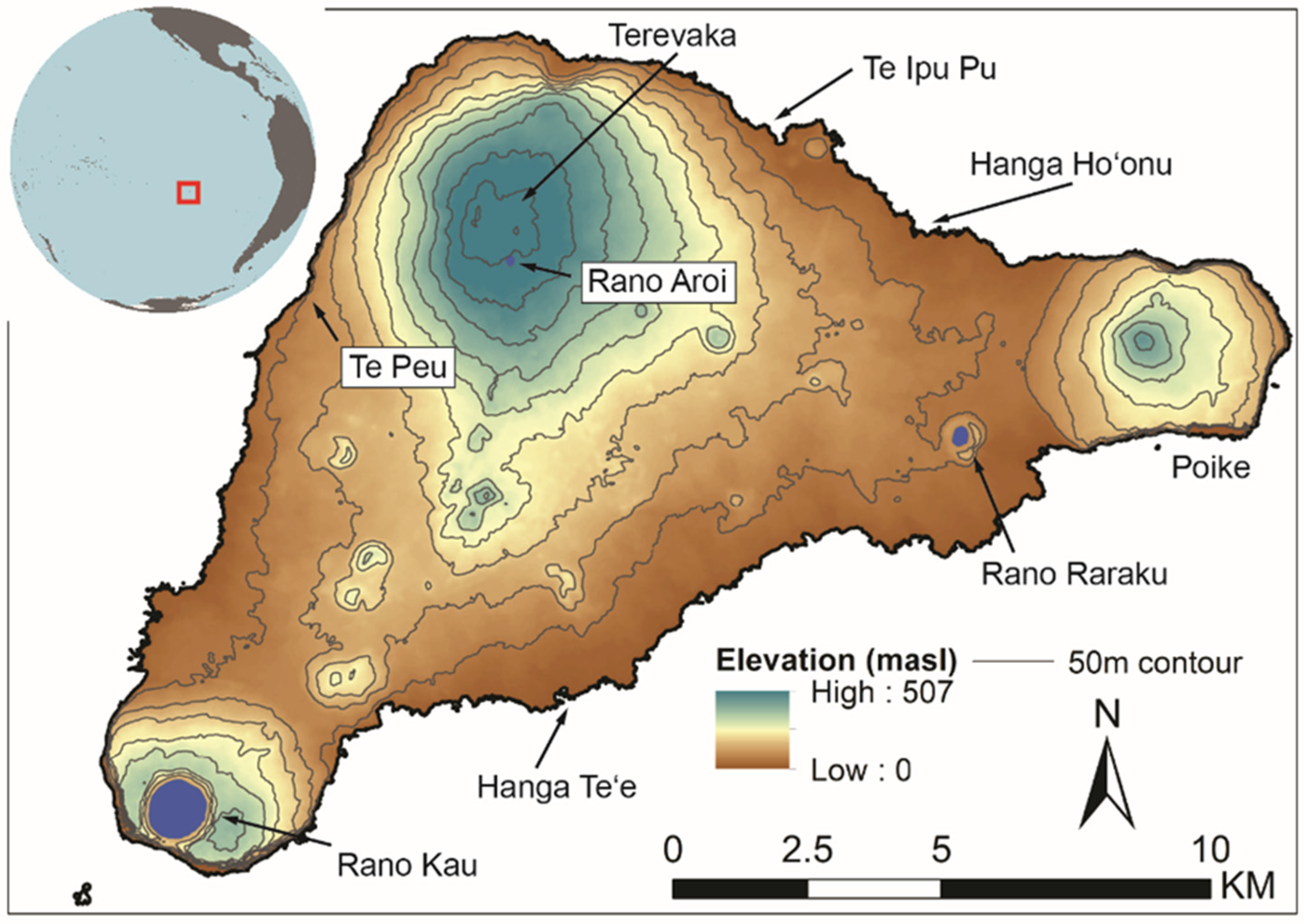
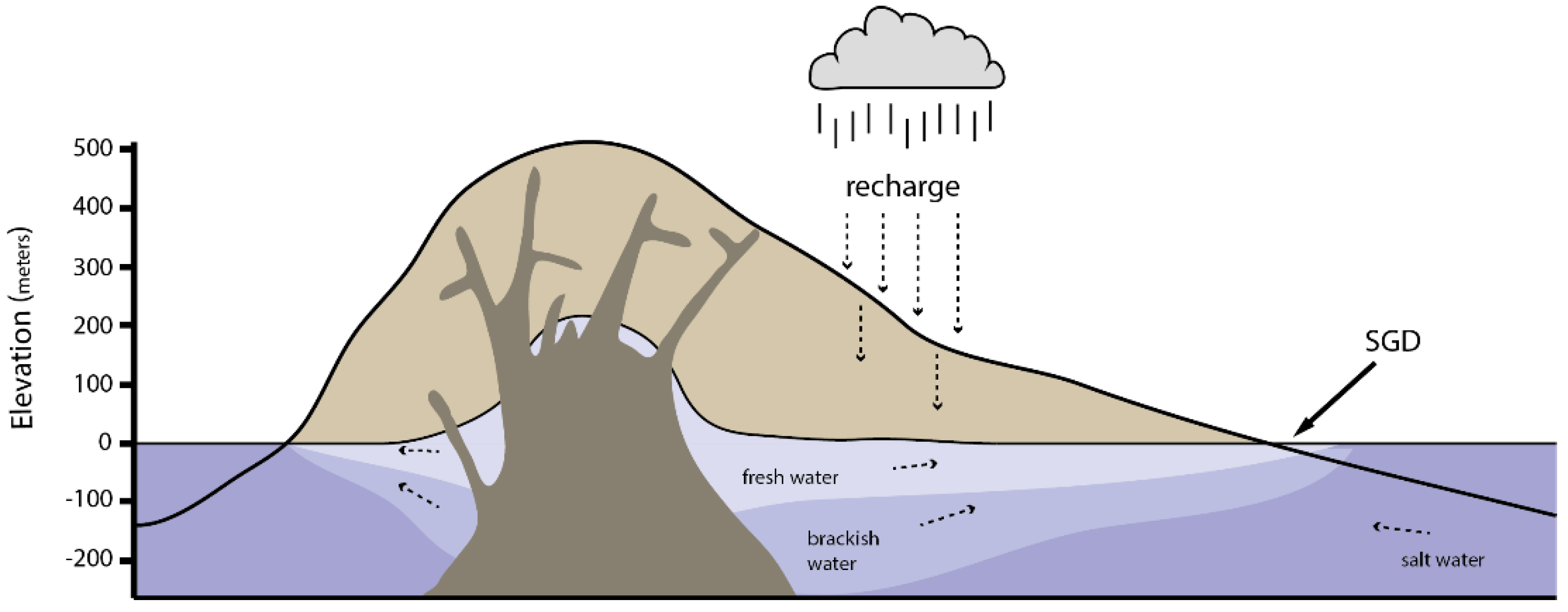
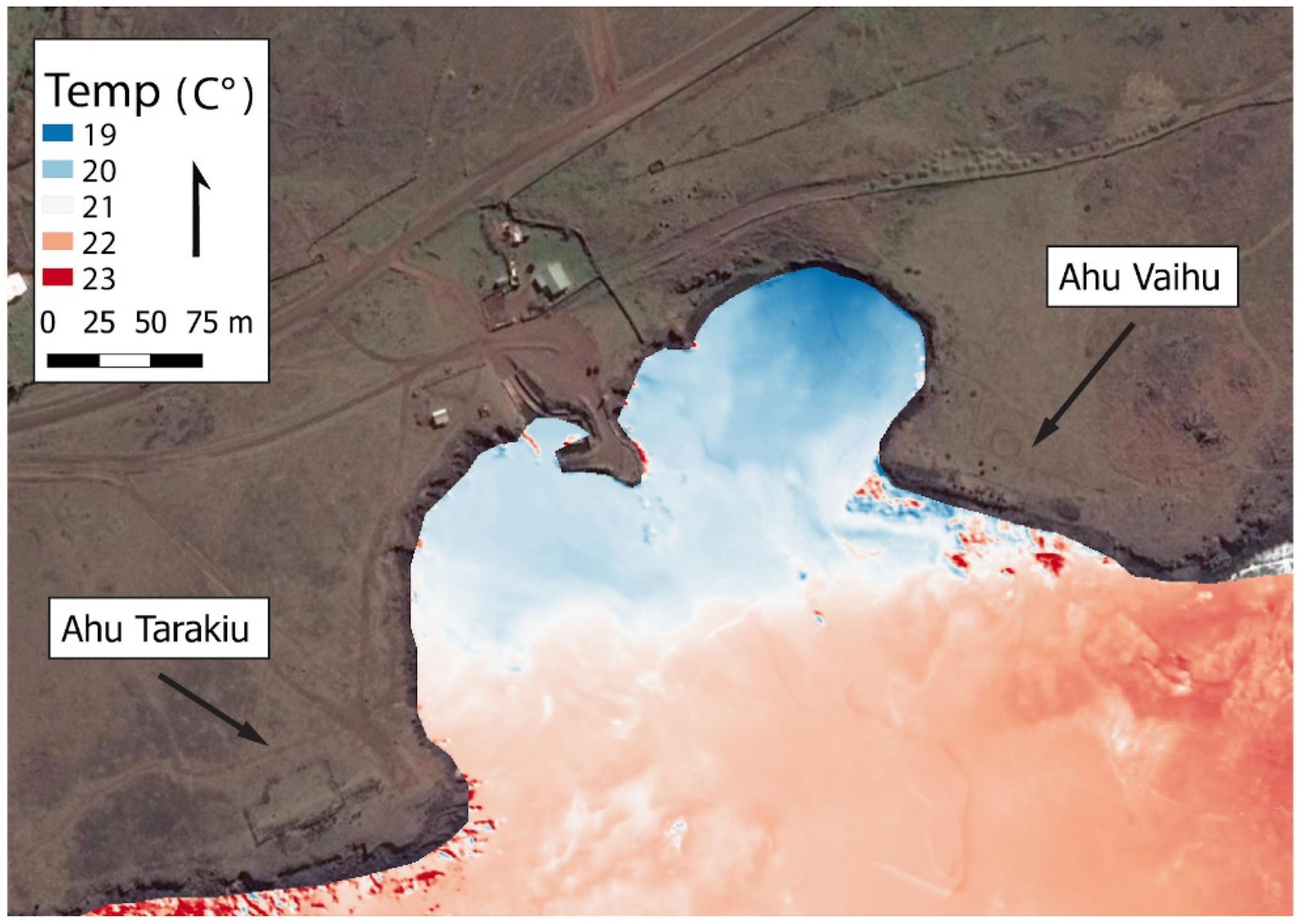
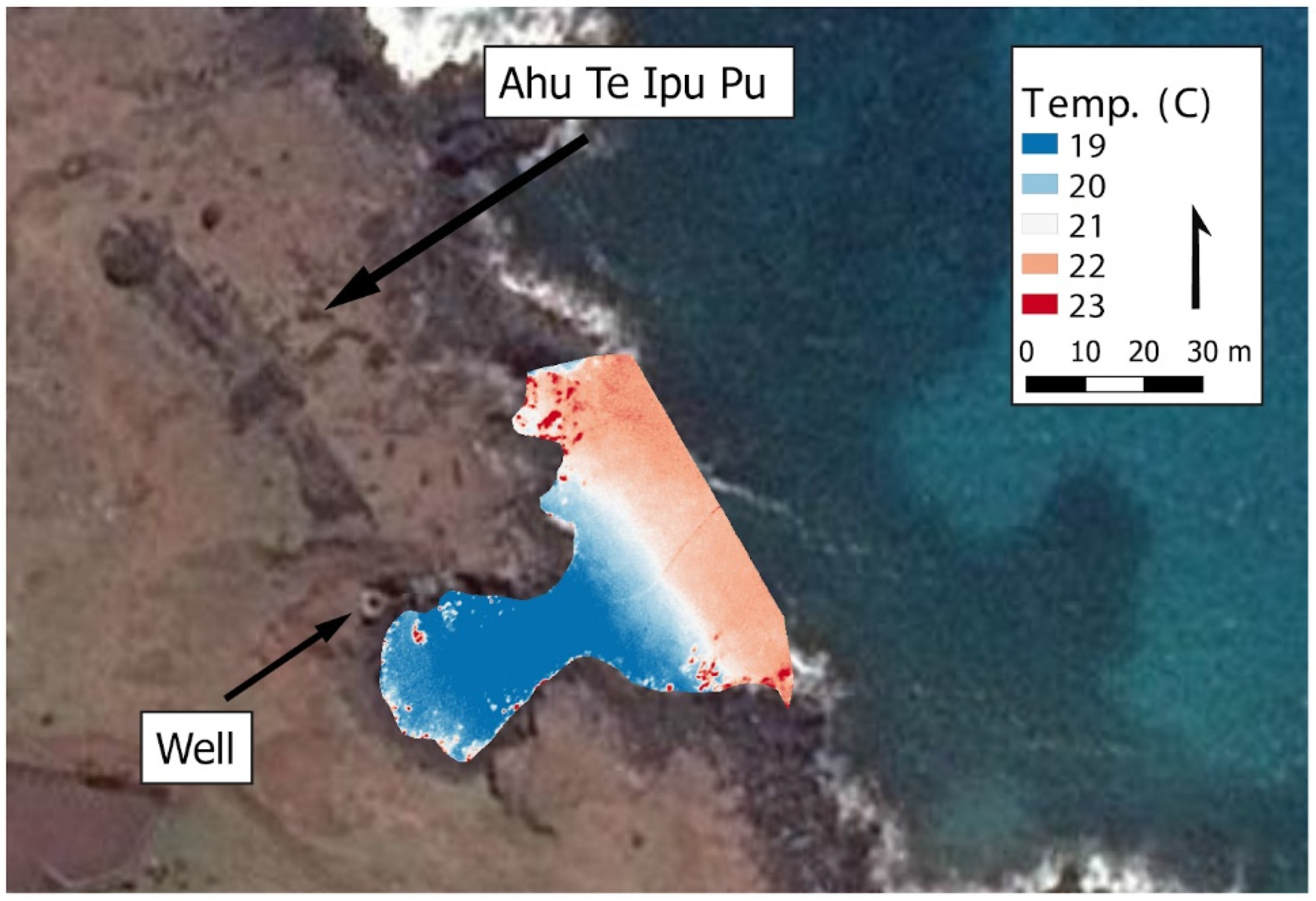
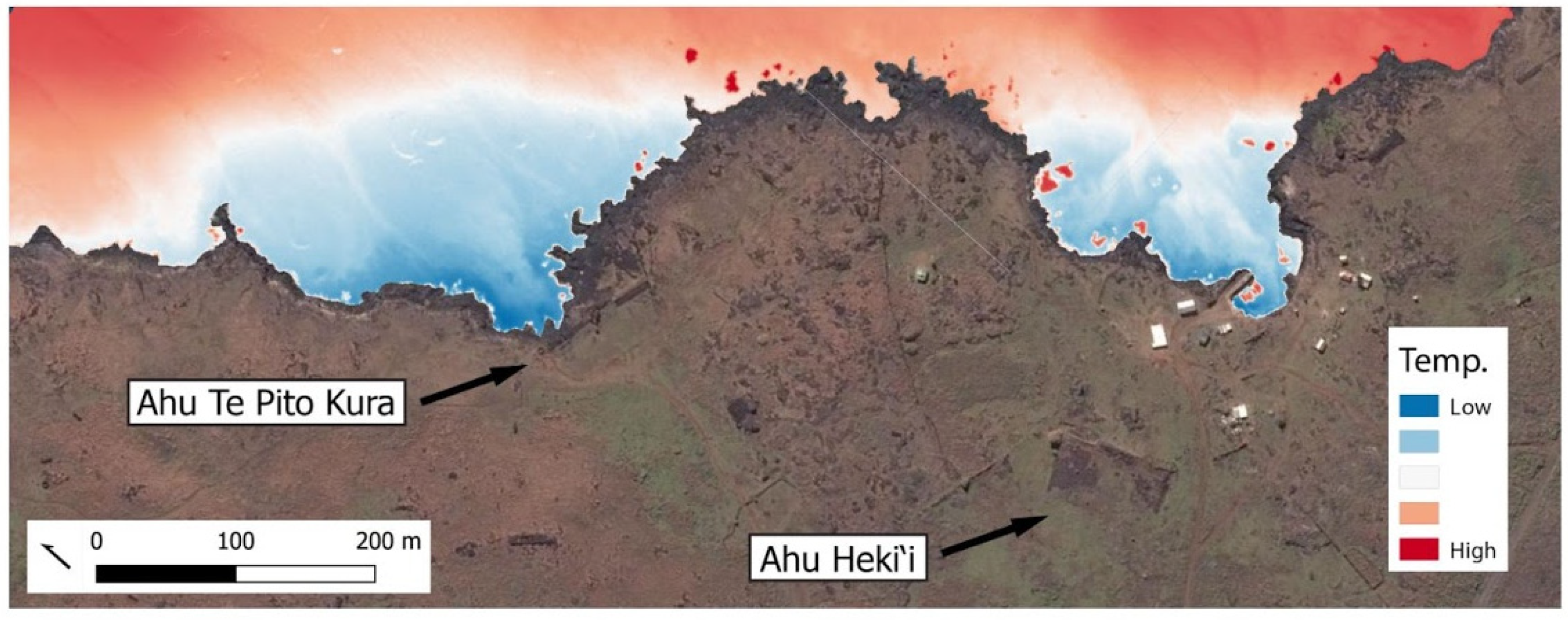
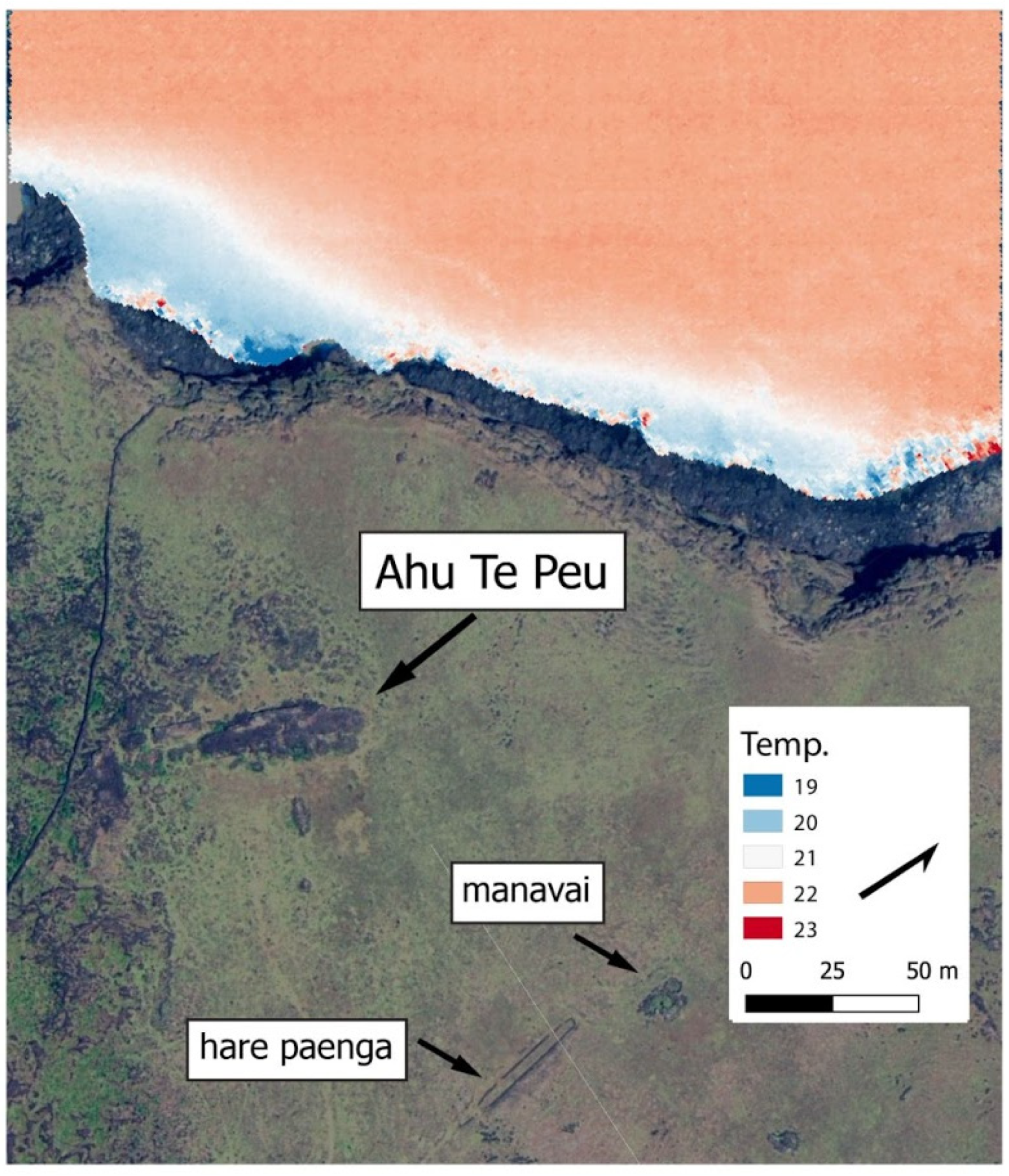
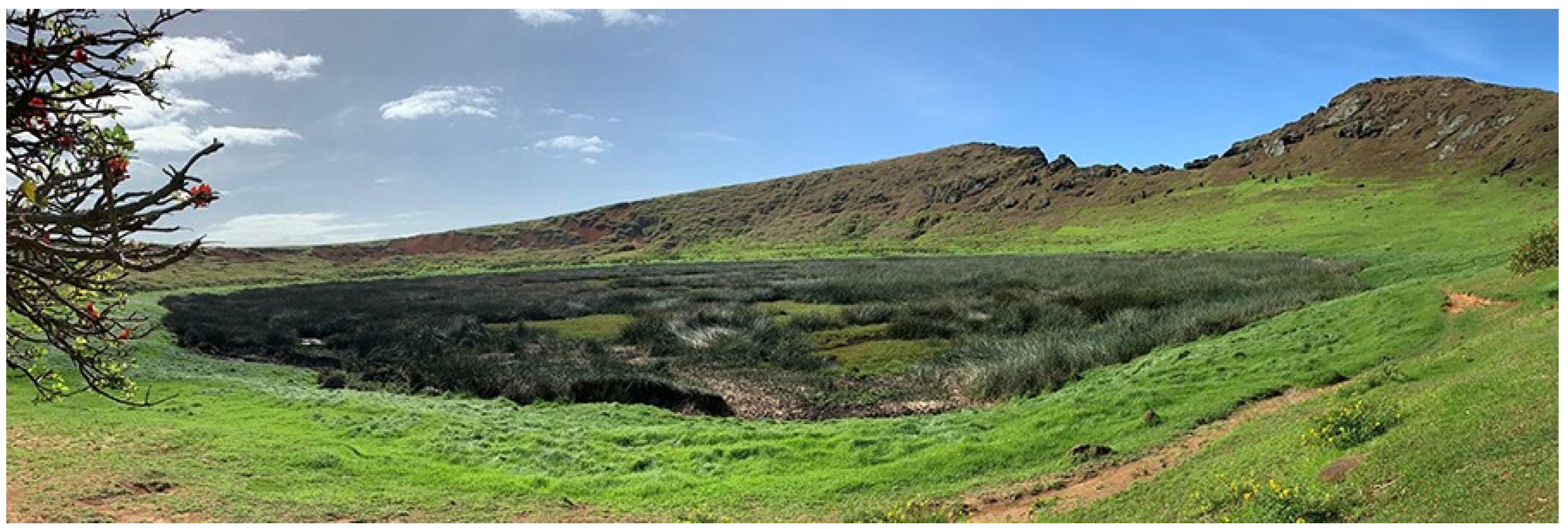
Publisher’s Note: MDPI stays neutral with regard to jurisdictional claims in published maps and institutional affiliations. |
© 2021 by the authors. Licensee MDPI, Basel, Switzerland. This article is an open access article distributed under the terms and conditions of the Creative Commons Attribution (CC BY) license (https://creativecommons.org/licenses/by/4.0/).
Share and Cite
DiNapoli, R.J.; Lipo, C.P.; de Smet, T.S.; Hunt, T.L. Thermal Imaging Shows Submarine Groundwater Discharge Plumes Associated with Ancient Settlements on Rapa Nui (Easter Island, Chile). Remote Sens. 2021, 13, 2531. https://doi.org/10.3390/rs13132531
DiNapoli RJ, Lipo CP, de Smet TS, Hunt TL. Thermal Imaging Shows Submarine Groundwater Discharge Plumes Associated with Ancient Settlements on Rapa Nui (Easter Island, Chile). Remote Sensing. 2021; 13(13):2531. https://doi.org/10.3390/rs13132531
Chicago/Turabian StyleDiNapoli, Robert J., Carl P. Lipo, Timothy S. de Smet, and Terry L. Hunt. 2021. "Thermal Imaging Shows Submarine Groundwater Discharge Plumes Associated with Ancient Settlements on Rapa Nui (Easter Island, Chile)" Remote Sensing 13, no. 13: 2531. https://doi.org/10.3390/rs13132531
APA StyleDiNapoli, R. J., Lipo, C. P., de Smet, T. S., & Hunt, T. L. (2021). Thermal Imaging Shows Submarine Groundwater Discharge Plumes Associated with Ancient Settlements on Rapa Nui (Easter Island, Chile). Remote Sensing, 13(13), 2531. https://doi.org/10.3390/rs13132531






